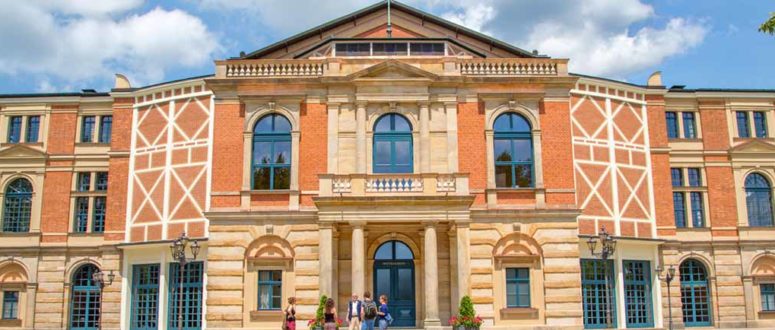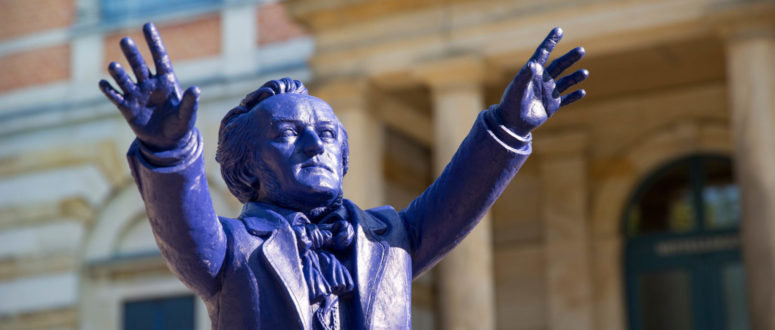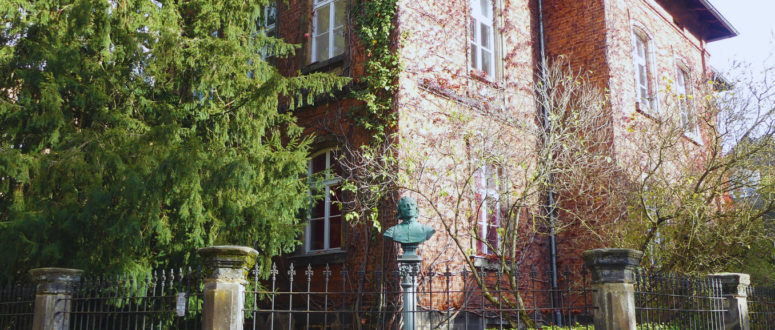The 19th century Bayreuth Festival Opera House of Richard Wagner is one of the largest opera houses in the world and known for its one of a kind acoustics.
Opera Festival
Every summer Bayreuth is a cultural center of artistic exploration of Richard Wagner`s music. The Bayreuth Opera Festival (Festspiele) has made the city of Bayreuth internationally famous, as well as the singers, directors and set designers. With the sound of the opening fanfares of the Richard Wagner festival, an international audience flocks into the city and the Festival Opera House on the green hill, whose foundation was laid there in 1872. With its one of a kind acoustics it captivates visitors year after year.
The life and work of Richard Wagner gave the former upper Franconian residence city Bayreuth a far reaching and new look in the 19th century. The circle of music lovers, who want to experience the entire works live, has become larger and larger and with this the chances to purchase tickets for the desired festival became smaller and smaller.
The opera festival begins on July 25th and continues until August 28th. With a changing plan of opera`s the stage is set each season with 30 performances for ca. 2000 spectators, many of them from foreign countries.
Place of music
Richard Wagner chose Bayreuth as the place for his opera festivals already in 1871. The margravial opera theater brought Richard Wagner to Bayreuth. At that time, the margravial opera theater had the largest stage in Germany which aroused Richard Wagner´s interest, as well as the location, which was half way between Munich and the capital Berlin, but still in the territory of his patron Ludwig II. It did not deter Richard Wagner, that in fact the margravial opera theater was for a Wagner music theater to small, to opulent, to furnished for pomp and representation. He had to have an Opera Festival House in Bayreuth, in spite of an alleged attractive offer from Chicago and the fact that King Ludwig would have preferred to have the opera house in Munich. After first designs from Gottfried Sempers were rejected, Richard Wagner hired the Leipzig architect Otto Brückwald, who took over some main features of Gottfried Sempers designs. 1872 the foundation was laid. The house was to be financed by patron shares which initially did not have the desired results so that King Ludwig had to ensure the completion of the house with a credit of 400.000 Marks.
The first opera festival was finally opened in 1876 with the premier of the Ring of Nibelungen under the eyes of emperor Wilhelm I and the Brasilian emperor Dom Pedro II. The list of attending composers reads like a list of “who is who” of classic music at the time: Tschaikowsky, Grieg, Gounod, Bruckner, Liszt und Saint-Saens. The festival house contributed its share to the myth of Bayreuth which began that day. What was and what makes the Festival Opera House special? How is it, that the Festival Opera House, at the time built with modest means as a pure summer theater, is mentioned in the same breath with the Metropolitan opera house in New York or the Sydney opera house? Why is it for example, that Placido Domingo in a TV interview, declared the Bayreuth Festival Opera House as the best one of all opera houses.
Surely it is not because of its plain, red brick façade, which reminds one more of an 19th century industrial building rather than an opera house. Also probably not because Richard Wagner designed it after antique design examples. This seen by itself is a quite interesting fact. All 1937 seats are placed in direct line of sight to the stage and over the steeply rising ranks of the audience room spans illusionistic the sun sail of the Greek theater.
The excellent reputation of the Opera House is due to the wood construction and the one of a kind acoustics. Also due to the up to 12 meter deep orchestra pit which brings the sound of the hidden orchestra in an indirect way into the auditorium. Last but not least due to the orchestra itself which is considered the best Wagner orchestra in the world, put together with the best musicians from great German orchestras. A soft, deep sound of the opera house arises not only from the orchestra pit but also from the Wagner myth itself.
Due to the special architecture, the singers can be heard clearer than anywhere else. Because the orchestra is not in front of the stage but underneath, which results in a direct contact of the singer with the audience. The sound of the orchestra is carried from the arched wall of the orchestra pit to the rear wall of the stage and this way the voices of the singers are somewhat carried out into the audience.
You find further information about the Festival Opera House and its building history, as well as many photographs on the official homepage of the Bayreuth opera festival under: www.bayreutherfestspiele.de
Short Video of the Festival Opera House
You are currently viewing a placeholder content from YouTube. To access the actual content, click the button below. Please note that doing so will share data with third-party providers.
More Information




